From Which Culture Does The Animal Head-post Of 834 Ce Originate?
The Oseberg Viking ship burial

In 1904 a remarkable archaeological site was uncovered at Oseberg, Kingdom of norway. It consisted of an astonishingly well-preserved Viking ship that contained the remains of two women along with a broad array of accompanying grave goods. This vessel, which is widely celebrated every bit one of the finest finds of the Viking Age, had been buried within a large mound or haugr.

The burial mound measured approximately 40m long by 6.5m loftier and information technology completely covered the boat. The conditions within the mound were peculiarly damp and this meant that the ship and its contents survived well-nigh intact. Constructed primarily out of oak planks, the vessel measured 21.40m long by 5.10m wide[i]. Its bow and stern were covered in elaborate carvings, while it contained 15 pairs of oar holes which meant up to thirty men could row the ship as required.
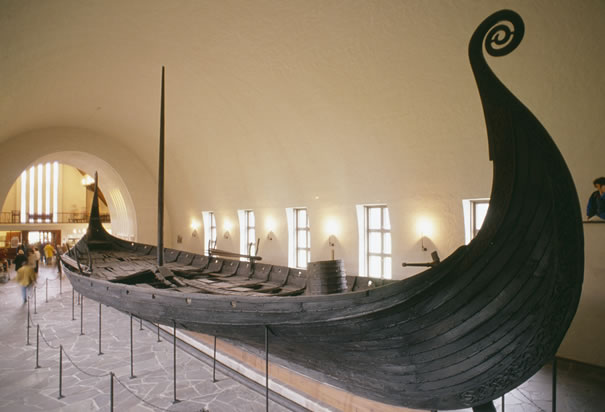
Centrally placed on the ship were the skeletons of ii women whose remains had been placed in a specially built wooden tent. 1 of the woman was in her eighties[2] and this was reflected in the condition of her bones which showed that she had suffered badly from arthritis during her final years. The second woman was younger and had died in her early fifties[iii].The connexion betwixt the two women is unclear; information technology is possible that they were related or more sinisterly represent the remains of a noble woman interred with her sacrificed slave. Indeed, some take speculated that ane of the women may exist Queen Åsa, the grandmother of Norway's first king, although this remains unproven.
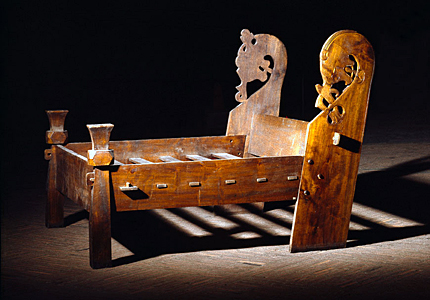
Radiocarbon assay of the women'southward bones indicated that they died c. 1220±twoscore and 1230±40 before present[iv] and this ties in with the dendrochronology dates from the burial tent timbers, which indicate information technology was constructed in 834 Advertizing[v]. Other skeletal remains found on the transport included 13 horses, four dogs and 2 oxen. It is likely that these represent animals that were sacrificed to accompany the female burials into the afterlife.
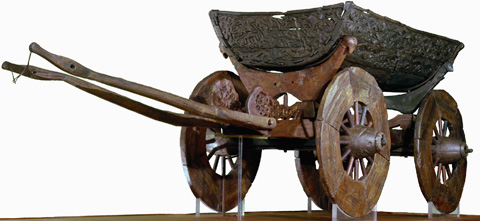
The grave was disturbed in antiquity and whatever precious metals that may have been nowadays were stolen. However, a remarkable collection of wooden and fabric artefacts were left behind by the grave robbers. These included four elaborately decorated sleighs, a richly carved 4-wheel wooden cart, iii beds likewise as a number of wooden chests. More mundane items such every bit agricultural and household tools were also found.
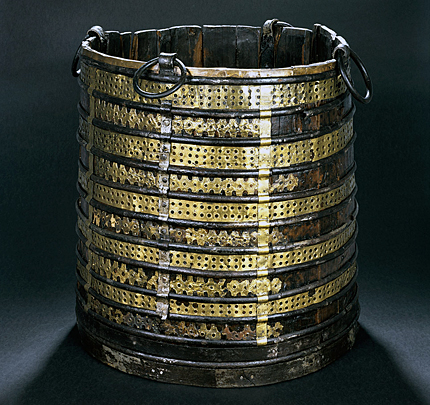
This bucket was one of several constitute on on the ship. Made out of yew woods it is surrounded by decorative brass fittings and held together with iron hoops. A wooden ladle and six-7 wild apples were plant within it.
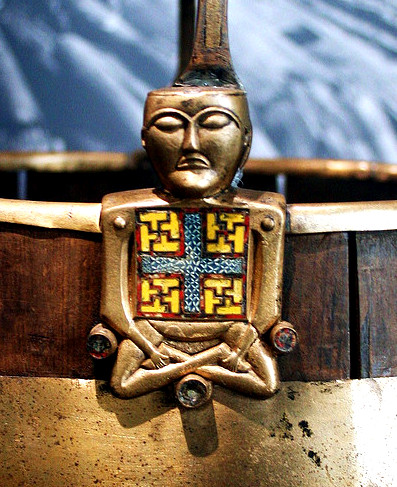
The famous Oseburg 'Buddha'. Sitting in the lotus position this stylised man figure is plant on another bucket from the send. This saucepan nigh probable originated in Ireland equally the decorative motifs on the 'Buddha' are paralleled in Irish art work about noticeably The Book of Durrow. This suggests that saucepan may represent booty captured during a Viking raid on Ireland.

Five of these zoomorphic posts, all carved with different animal heads, were plant in the Oseberg burial. They are fashioned out of maple wood and are of similar size. The posts contain slots for handles suggesting that they were originally carried and it is likely they had some sort of magical or religious significance.

Four wooden sledges were besides uncovered, three of which, were covered in ornate carvings.
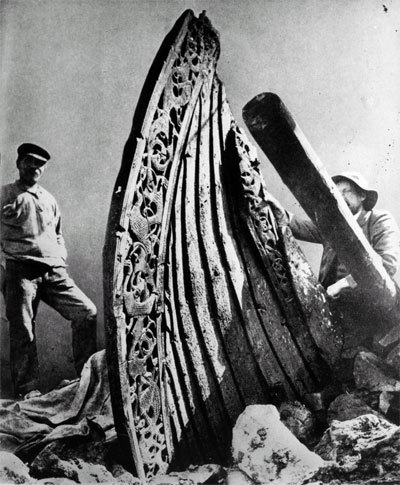
The Oseberg ship and its treasure trove of artefacts are currently on display at the Viking Ship Museum, Oslo, Norway.
.
by Colm Moriarty
.
Related posts
.
.
Footnotes
[i] Nordeide SW. 2011. Decease in abundance quickly! The duration of the Oseberg Burying. Acta Archaeologica 82(i):7-11.
[two]ibid.
[iii] ibid
[iv] Holck P. 2006. The Oseberg ship burying, Norway: New thoughts on the skeletons from the grave mound. European Journal of Archæology 9(2-3):185-210.
Source: http://irisharchaeology.ie/2012/09/the-oseberg-viking-ship-burial/
Posted by: gravesexcums.blogspot.com

0 Response to "From Which Culture Does The Animal Head-post Of 834 Ce Originate?"
Post a Comment